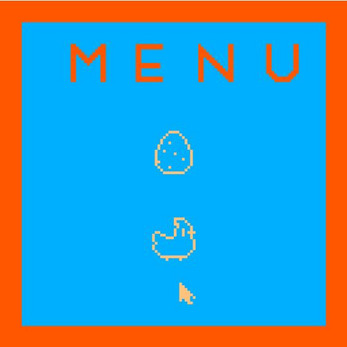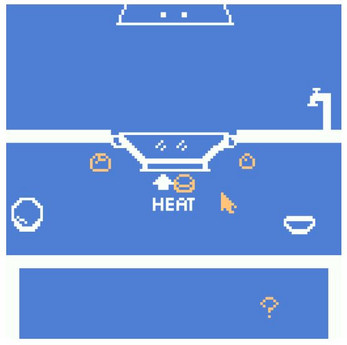Simple Chinese Cuisine Tutorial
Want to learn some simple Chinese dish? Come and try!
Control the mouse arrow to choose and cook the dish step by step. You can always check the recipe by the question mark at right corner side.
Never thought this game will take me 8 or more hours to finish...



Comments
Log in with itch.io to leave a comment.
It is really interesting to experience a cooking game like this. I only watched others to play Overcooked and it is all about the simulation of cooking and cooperation. However, this game is much different. What I can describe is that it translates the cooking videos from YouTube into the game form, which teaches you the traditional Chinese dish through the text messages and visual elements in the game.
Personally, I love cooking, and there is always a debate about whether you should put sugar in the dish Scrabbled Eggs and Tomatoes. And my way of cooking it is always to put some sugar in order to increase the flavor. There is a measurement for this: if you can taste the obvious sweetness in the dish, you have actually put too much sugar in the dish and you may want to reduce the amount in the next time. In this game, you have to strictly follow the steps or you will have to restart all over otherwise, but there is a exception where the designer allows you to not put the seasoning in the dish and proceed the game. This is surprising to me since I restarted so many times before and it is a relief when I finally got me dish cooked.
The tiles in the game are composed in a way that represents the shapes of necessary ingredients in the dish, and it allows players to immerse themselves more in the cooking procedure. The heat button was always distracting me since it is in the center of the scene and I can accidentally trigger the conversation every time when I passed through it. When I got the eggs, the color of the room is changed to pink and yellow, which I assumed that the aim is to mimic the heat of the actual cooking. It is also nice that the designer added a question mark in the bottom of the scene for players to check the recipe in case that they forgot it, and I am one of the players who get benefits from it.
The text messages are the most important part in the game. In fact, it teaches you the whole process of how to successfully make the dish and its steps. The text will change based on your steps. If you did not follow the correct steps, the text will show a different conversation and you will have to restart the game. It functionality is to keep track of the changes in variables and show the corresponding game content.
Timmexy's game "Simple Chinese Cuisine" was an enticing and interesting game that taught the player how to make the dish "Scramble eggs and tomatoes". This game was made using the engine Bitsy. Additionally, there was a light-hearted guitar track that played as the dish was made. The game is the steps it takes to make the dish, from gathering the ingredients, to cooking them, to seasoning them. The different steps and the music helped to create the atmosphere of making food. I know that when I cook, I listen to acoustic or instrumental music quite frequently.
The different steps immersed me into the game even more. I especially appreciated the recipe box at the bottom right of the screen. This created a cooking experience because when I cook, I frequently pause and take a look at the recipe to remind myself of what is going on. The color pallet also immersed me because there was a change in the colors as the dish progressed. The colors got brighter and it made me as a player feel happier. I felt like what I was doing had consequences on the game and making a change for the better.
I was also impressed with the mechanics of the game, particularly the transitions. Every time that I successfully completed all the steps, the game moved onto the next step seamlessly. I didn't have to physically take my player to the next room. The game transitioned without player input. The game was also designed quite well. The space was constructed like a kitchen with the wok and oven fans in the middle and the ingredients strewn around in various locations. This helped me to feel like I was physically in a kitchen.
Another aspect of Timmexy's game that I appreciated was the moments of failure. Rarely do you get a dish right the first time without consulting a recipe. I didn't realize there was a recipe in the game and so tried to "speed run" the game. I put in the wrong ingredients twice and had to start all over until I looked at the recipe and understood the order and matter of what the dish required. This worked well to help me "learn the dish" as well as to do it correctly. It was like real life in those moments of failure.
Overall, I think this game is a great start for a larger game focused on cooking. In our class, we have talked about how educational games are like chocolate-covered broccoli. I think that Timmexy's game toes this line well by having a game that has real life ramifications (knowing how to cook) but does it in a fun and exciting way. The music adds to a good mood when playing the game. The game is designed with fun descriptions and visuals so that it doesn't feel like I'm learning but I am learning how to cook. It's a nice light hearted way of learning a craft. I am excited to make this dish in my own kitchen now that I've learned how to cook it!
I am surprised to see how the designer use Bitsy to build this engaging game. Personally, I love cooking, and I know how to make this tomato scrambled egg dish. This game is taking the cooking experience to the next level. The designer organized the space in a way that is similar to a Chinese kitchen setup. For example, the stir-fried pot is in the center of the screen with the fan on top of it. In addition, there are seasoning bottles over the counters. There are also some contrasts in the setups. One thing I noticed is the color change for each scene. The colors get brighter after each scene, and the designer even made the last scene looks like the color of the tomato scrambled egg. There are no “visible” entrances/exits, they are embedded in the interactive elements. For instance, the player could process into the next scene when they finished preparing the main ingredients. Some of the objects have more attention than others. The interactive objects are definitely having more attention from the players, but I found the recipe object (the one as ? at the lower right corner) does not have as much attention I thought. For instance, maybe is because I know how to cook this dish so I know what is going on, but I didn’t use the recipe hint as often. I think it could be somewhat better if the recipe is shown at some point at the begging of the game to have the player have a general idea of what they are supposed to do.
I guessed one of the designer’s design goals is to create this interactive recipe. With this idea in mind, I believe the designer perfectly fulfilled this goal. Players need to follow certain orders on how/when to put ingredients together. This order helps the player to understand the correct way to cook this dish and the order matters in this case. Therefore, choices matter in this game. If the player didn’t follow the order and make their own decision, sometimes it could “ruin” the dish and result to start over the game.
Some moments I remember in the game were seasoning. I know some people like to make this dish salty while some want it to be sweet. I think it is interesting that the designer included this detail in the game. The player could choose one of them or do both salt and sugar. Personally, I usually use both in my dish in reality, so it makes me feel that I have some freedoms in the game experience. I was curious about how the visuals of this game are going to turn out. It is very appealing when the player mixes the egg and the tomato in that last scene. It looks realistic in my opinion.
Overall, I would recommend this game to my friends because it is a fun way to learn how to cook a dish, and also shows a different kind of perspective of cooking.